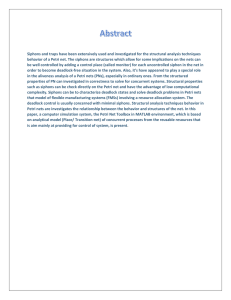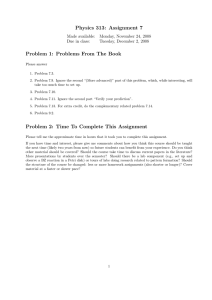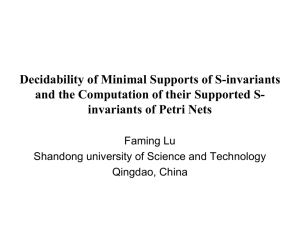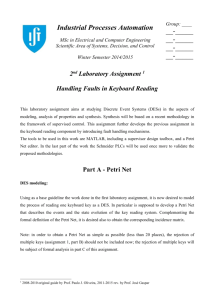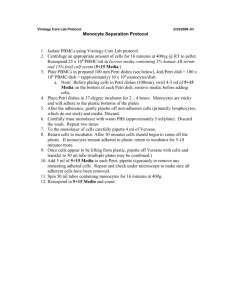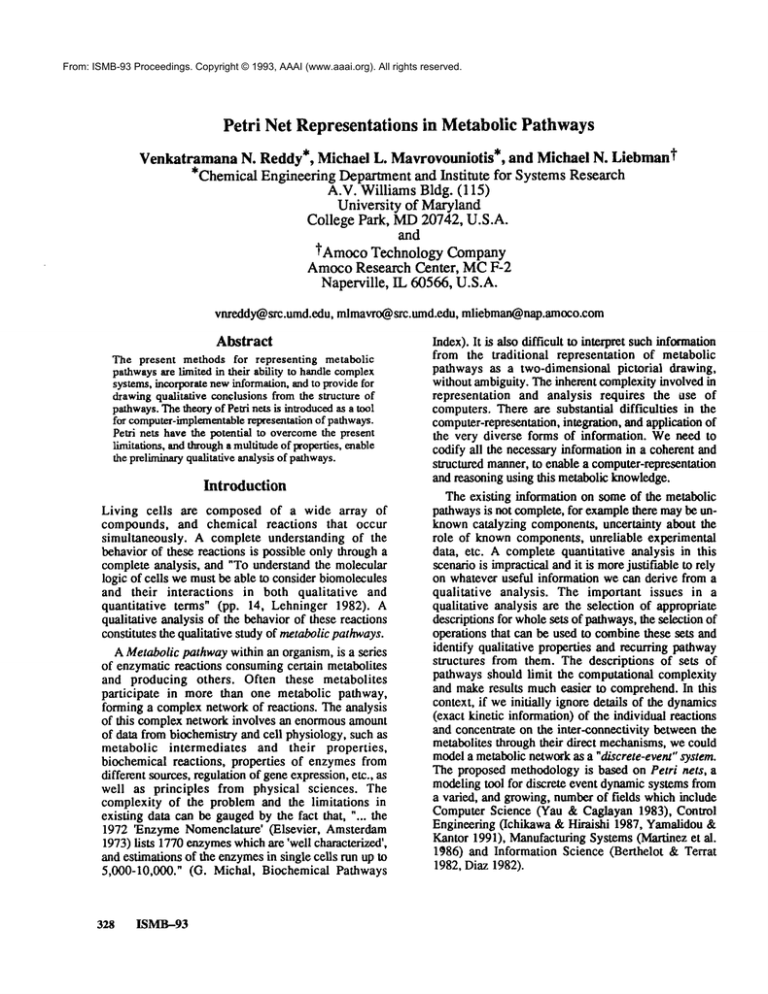
From: ISMB-93 Proceedings. Copyright © 1993, AAAI (www.aaai.org). All rights reserved.
Petri Net Representations in Metabolic Pathways
Venkatramana N. Reddy*, Michael L. Mavrovouniotis*, and Michael N. Liebmant
*Chemical Engineering Department and Institute for Systems Research
A.V. Williams Bldg. (115)
University of Maryland
College Park, MD20742, U.S.A.
and
tAmoco Technology Company
Amoco Research Center, MCF-2
Naperville, IL 60566, U.S.A.
vnreddy@src.umd.edu,mlmavro@src.umd.edu,mliebman@nap.amoco.com
Abstract
The present methods for representing
metabolic
pathwaysare limited in their ability to handle complex
systems, incorporate newinformation, and to provide for
drawing qualitative conclusions from the structure of
pathways.Thetheory of Pctri nets is introduced as a tool
for cornputer-implementablerepresentation of pathways.
Petri nets have the potential to overcomethe present
limitations, and through a multitude of properties, enable
the preliminary qualitative analysis of pathways.
Introduction
Living cells are composed of a wide array of
compounds, and chemical reactions that occur
simultaneously. A complete understanding of the
behaviorof these reactions is possible only througha
completeanalysis, and "To understandthe molecular
logic of cells wemustbe able to considerbiomolecules
and their interactions in both qualitative and
quantitative terms" (pp. 14, Lehninger 1982).
qualitative analysis of the behaviorof these reactions
constitutes the q,mlitative studyof metabolicpathways.
A Metabolicpathwaywithin an organism,is a series
of enzymaticreactions consumingcertain metabolites
and producing others. Often these metabolites
participate in more than one metabolic pathway,
forminga complexnetworkof reactions. Theanalysis
of this complexnetworkinvolves an enormousamount
of data frombiochemistryand cell physiology,such as
metabolic intermediates and their properties,
biochemical reactions, properties of enzymesfrom
different sources,regulationof geneexpression,etc., as
well as principles from physical sciences. The
complexity of the problem and the limitations in
existing data can be gaugedby the fact that, "... the
1972 ~EnzymeNomenclature’ (Elsevier, Amsterdam
1973)lists 1770enzymes
whichare ’well characterized’,
and estimationsof the enzymes
in single cells run up to
5,000-10,000." (G. Michal, Biochemical Pathways
328 ISMB-93
Index).It is also difficult to interln’et suchinformation
from the traditional representation of metabolic
pathways as a two-dimensional pictorial drawing,
withoutambiguity.Theinherent complexityinvolvedin
representation and analysis requires the use of
computers.There are substantial difficulties in the
computer-representation,
integration, andapplicationof
the very diverse forms of information. Weneed to
codify all the necessaryinformationin a coherentand
structured manner,to enablea computer-representation
andreasoningusing this metabolicknowledge.
Theexisting informationon someof the metabolic
pathwaysis not complete,for examplethere maybe unknowncatalyzing components,uncertainty about the
role of knowncomponents,unreliable experimental
data, etc. A completequantitative analysis in this
scenariois impracticalandit is morejustifiable to rely
on whateveruseful informationwe can derive from a
qualitative analysis. The important issues in a
qualitative analysis are the selection of appropriate
descriptionsfor wholesets of pathways,the selection of
operationsthat can be used to combinethese sets and
identify qualitative properties andrecurring pathway
structures from them. The descriptions of sets of
pathwaysshould limit the computationalcomplexity
and makeresults mucheasier to comprehend.In this
context, if weinitially ignore details of the dynamics
(exact kinetic information)of the individual reactions
and concentrateon the inter-connectivity betweenthe
metabolitesthroughtheir direct mechanisms,
wecould
modela metabolicnetworkas a "discrete-event"system.
The proposed methodologyis based on Petri nets, a
modelingtool for discrete event dynamicsystemsfrom
a varied, and growing,numberof fields whichinclude
ComputerScience (Yau & Caglayan 1983), Control
Engineeringflchikawa &Hiraishi 1987, Yamalidou&
Kantor1991), ManufacturingSystems(Martinezet al.
1986) and Information Science (Berthelot & Terrat
1982,Diaz1982).
2
3
tl
P5
t6
Fig. 1. APetri net graphwith places,transitionsandarcs.
Thepurposeof this paperis to introducea methodof
representationof metabolicpathwaysas Petri nets, and
illustrate someuseful properties that can be determined
fromsuch a representation.
Petri nets
Theessential conceptsin Petri net theoryrelevantto our
analysis are summarized
below.This is merelyan introduction, and a complete review of the theory and
applications are available in literature (Murata1989;
Peterson1981).
APetri net (PN)is a graph (Fig. 1.) formedby
kindsof nodes,called places(p j) andtransitions(tj).
Directed edges, called arcs, connect places to
transitions, and transitions to places. A non-negative
integer numberof tokens is assignedto eachplace, and
it can vary basedon the state of the Petri net. Eacharc
has a weight,a positivenon-zerointeger, assignedto it.
Pictorially,
places
arerepresented
bycircles,
transitions
bybars
orboxes,
ares
bylines
ending
inanarrow,
and
tokens
asblack
dots
placed
inthecircles.
Generally
if
there
isnoarc-weight
specified
onthegraph
weassume
ittobeequal
toone.
Eachtransition (event) is associated with a finite
numberof input places (pre-conditions) and output
places (post-conditions). A transition is enabledwhen
the number
of tokensin its input places is greater than
or equalto the weightson the arcs connectingthe places
to the transition. A transition with no input places,
calleda sourcetransition, is alwaysenabled.In Fig. 1.,
the transitions t 1 andt4 are enabled,whilethe rest are
not Anenabledtransition can fire, depositingtokensin
its output places, again their numberdeterminedby the
arc-weights.Atransition with no outputplaces, called a
sink transition, can fire whenenabledconsumingthe
tokensfromits input places. Fig. 2. showsthe samePN
after the enabledtransitions are fired, in tamenabling
other transitions. Theslate of a PN,whichis the number
of tokenspresentin the individualplaces, is denotedby
Mand called the marking of the net. The initial
markingof a PNis denotedby M0.Thus,the firing of a
sequenceof transitions maychangethe markingof the
net. AmarkingMis reachablefrom M0if there exists
somefiring sequencethat accomplishes
this change.
Mathematically
a Pelri net is representedas PN= (P,
T, E,W,M0); where
P = { Pl’ P2’ P3 .... Pm} is a finite set of
places
T= { t 1, t 2, t 3 .... tn } is a f’miteset of
transitions
E ~ (P x T) u (T x P) is a set of
W:E -~ { 1, 2, 3 .... } is a weightfunction
M0:P -~ { 0, 1, 2 .... } is the initial marking
P andT beingdisjoint sets
Since the Petri net is presented as a modelfor a
discrete-eventsystem,it is helpful to havea systemof
equationswhichcan be used to specify and manipulate
the state of the system. Wecan examinethe dynamic
behaviorof a Petri net, with mplacesandn transitions,
if weformulatea state-spaceequationof the type
Mk = Mk.j + AT uk, k = 1, 2, 3 ....
(1)
where,
k represents a point in a fh-ing sequence;M
k
an mx 1 vector, the markingafter the kth fwing;uk an
n × 1 vector, the control vector indicating the
Reddy 329
2
2
t4
2
P3
3
t1
t6
P5
Fig. 2a. Markingafter f’wing enabled transitions t 1 and t 4 fromFig. 1.
2
3
tl
Pl
P5
t6
Fig. 2b. Markingafter t’wing in sequencet 2, t 3, t5, and t 6 from Fig. 2a.
transition fired at the kth fwing; and Aan n x mmatrix,
the incidence matrix whose elements aij denote the
change in the number of tokens in place j due to the
firing of wansitioni.
If a particular markingMn is reached from the initial
marking Mo, through afiring sequence o = { u1, u2,
u3 .... un }, and the state-equations are summed
for all
the t-wings in this o, weobtain
n
if we define x = E uk ’ we obtain
k=l
Mn - M0 = ATx
(3)
A T X = AM
(4)
or
n
Mn = Mo + AT~Uk
33O ISMB-93
(2)
where x, an n × 1 vector, is called thefiring count
vector. The element i in x indicates the numberof times
transition
i must fire in order to transform M0to M
n.
Trypsin
Hexokinas¢
¯
&
(active)
Glucose
G6P
6~~~’~t~
Chymp
ATP
Chymotrypsin
/ v \
Protein
-,-,-o,~o.~,.~lysis
Fig. 3a. Eachplace represents a biological
compound. G6P: Glucose-6-Phosphate.
It is nowevident that a necessary condition for the
reachability of Mn from Mois the existence of a
solution to Eqn. (4), the elements of x being nonnegative rational or integer numbers. Although the
rational solutions for x have no physical interpretation,
since fractional firings of transitions are not realizable,
they can be transformed to integer numbers by
multiplying Eqn. (4) with an appropriate scalar
constant. This does not alter in any way our condition
for the reachability of Mn from Mo.
Metabolic
Pathways
Representation
The representation of the essential components in a
metabolic pathway, using Petri net terminology, is the
first step in modeling the metabolic network as a
discrete-event system. Petri nets, amongother methods,
have been reported ( Kohn& Letzkus 1983) as graph
theoretical tools for the representation of biochemical
reaction systems. Although the representation of the
system as a Petri net is not unique, proper choice of
mappingis essential in determining the utility and
applicability of the method.
For metabolic pathways, places would represent compounds (such as metabolites, enzymes, cofactors etc.)
participating in a bioreaction. Wecould have one place
represent one compoundor we could have two or more
places represent the same compound,based on their
physical attributes or distinct functions. For example,in
Fig. 3a, each place represents one biological compound,
whereas in Fig. 3b, two places represent the same compound, due to their difference in activities. Oneplace
represents the inactive zymogenand the other the active
Fig. 3b. In this case two places represent forms
of the same compound,one is the zymogenand
the other the enzyme.
enzyme Chymotrypsin. As another example, if we
would like to distinguish between compoundsbased on
their location in the cell (or organelle), we could have
different places represent the same compound. For
example, the ATP pools inside and outside the
mitochondrionin a cell are different and their relative
concenwationsdetermined through a selective transport
process. Hence, we could have two places, one
representing the compound inside and the other
representing the compoundoutside the mitochondrion.
In the same way we assign transitions to represent
individual reactions or a series of forward reactions
when the intermediary compoundsare not of primary
interest. Tokens indicate the presence of a compound.
Arc-weights represent the stoichiometry of reactions,
and the direction
of an arc is based on the
thermodynamicfeasibility of the reaction. The example
in Fig. 4b, illustrates these mappings. To keep the
figures simpler, we allow the same place to appear mote
than once in the drawing of a PN, such as ATPin Fig.
4b. From the viewpoint of Petri net simulation and
properties, we consider all of the appearancesof ATPin
Fig. 4b. to represent only one place.
A representation of a pathwayshould allow a certain
level of abstraction, to enable us to look at the pathway
from a different ’perspective’. In a group of pathways
which are made up of similar compoundsbut behave in
a dissimilar manner(dependent on their functionality),
it maybe possible to identify certain commonpatterns
of interactions
(templates)
among the similar
compounds, by some means of abstraction.
The
hypothesis is that these pathwaysmight have diverged
fromtheir primitive templates to their present state, the
divergencebeing task-dependent. Thus, it is possible to
examinethe difference in behavior of the pathwaysin
Reddy
331
Fructose
-
Fructose- 1-phosphate (furanose)
Fructose-1-phosphate
+
~
ATP
NADH
(open chain)
NAD
Glycerol
Glyceraldehyde-3phosphate
1
Dihydroxy acetone
phosphate
~hate
Glycolysis
Fig. 4a. Fructosemetabolism
in liver (pp. 454, VoetandVoet1990).All the reactions
are catalyzed by enzymes.
relation to structural modificationof the templates.An
example of a set of pathways which mayhave this
homologyis the cascade mechanismof activation of
serine proteases in the blood-coagulationpathway,the
complement
system,andthe differentiation in the fruit
fly.
Thepresent knowledgeof metabolicreactions is incompleteand wewouldlike a representation whichcan
be extended upon the present state of knowledge,
without significant deviation from the existing
structure. Petri nets havethis extendibilityembedded
in
the methodology.A transition represents an event
whichrequires certain pre-conditions and results in
somepost-conditionsif the eventactually occurs. If we
nowconsider this event as a combinationof other
events, wecan visualize a transition that emulatesa
Petri sub-net. Anymodification to this sub-net is
reflected in the behaviorof the original transition. This
can be well understood in the context of an Object
Oriented Programmingframework, where one object
inherits attributes of other objectsthat it contains.For
instance, in Fig. 4b, the transitions have places
corresponding to the metabolites involved in the
reaction. Eventhough there maybe other compounds
participating in the reaction, such as enzymes,
coenzymes,metal ions, etc., they are implicit in the
action of the transition. However,
in the eventthat new
332
ISMB-93
informationis to be incorporated,it is a simple~k to
modifythe sub-net characterizedby the transition, to
reflect the changein our state of knowledge.
Propertiesof Pathways
Therepresentation of metabolicpathwaysas Petri nets
is of valuebecausethe properties of Petri nets can be
applied to the pathway, leading to relevant
observadons.
Liveness.A Petri net is said to be live, if fromany
markingreachable fromMoit is possible to fire any
transition in the net through somefurther firing
sequence.For a metabolicpathwaythis is a condition
that, in any state of the biotransformation, all the
individualreactionsare potentiallyactive. If the PNof
+,
Fig. 4b. is live, then one moleof each of ATP,NAD
NADH,
and Fructose is sufficient to enable each
enzyme
to act at least once.
Reachability. A necessary condition for a marking
M
n to be reachable fromthe initial markingM
o is the
existenceof a non-negativesolution to Eqn. (4). This
condition becomessufficient if weadd the following
requirement.All markingsin the firing sequencefrom
M0to Mn must be covetable, i.e. there must exist a
Fructose
(furanose)
0
F1P (open chain)
ATP_
~
+
f’-~NADH
~’~,NAD
j%¢’
ADP.
Glycerol
ATP
Glyceraldehyde
GAP.
P
~Gly
D~~
Glycolysis
c3P
~
NADH
+
NAD
Fig. 4b, PNrepresentation of pathwayin Fig. 4a. Thereis an one-to-onemappingbetween
places andmetabolites.
minimum
markingsuchthat the transitions in the firing
sequencefrom Moto M
n are enabled.
Thereachability of a markingfrom someother marking, in the PN model of a metabolic pathway,
determinesthe possibility of formationof a specifiedset
of product metabolites from another set of reactant
metabolites, by somesequenceof reactions whichis
dictated by the PN’sfning sequence(s).Thesufficiency
condition can be envisioned as the necessity for the
presence of certain essential compounds,like the
enzymesto particular reactions or their required
cofactors. In the PNmodelof Fructosemetabolism,the
pathto Glycolysisis possiblesince there is at least one
possible firing sequencefrom Fructose to GAP(viz.
Fructose, F1P, Glyceraldehyde, GAP,and finally
Glycolysis)
Reversibility.APetri net is said to be reversibleif the
initial markingM0is reachablefromall other possible
markingsin the set of markingsreachable from M0.A
markingM’is a homestate if it is reachablefromall
other markingsin the set of possiblemarkingsof a Pelri
net.
Mostmetabolicpathways
are not literally reversible,
dueto the thermodynamic
irreversibility of manyreactions. However
an alternate set of reactions mayreproduce the precursor metabolites. This constitutes a
regulatory function whichcan shift the metabolismin
either direction, with the aid of pertinent enzymes,dependingon the need for the compounds.Reversibility
of a Petri net is a property which could test the
possibility of such an alternate set of reactions. One
such reversible pair of pathwayswhichcan be modeled
and analyzed with this property is the GlycolysisGluconeogenesissystem.
Fairness. Thereare different definitions to fairness,
but the one that is of relevanceis Unconditional(or
Global)fairness. If a firing sequencecr is finite or if
everytransition in a occursinfinitely often, then cr is
globallyfair. APetrinet is globallyfair if every(r in all
possiblemarkingsfromM0is globallyfair.
Reddy 333
()
r
\
-~
~
£ 7",
Fig. 5. Someexamplesof structural reductions that are possible in PNgraphs
A pathway that has the property of global fairness
suggests the existence of a state of continuous
operation, starting from an initial state, without outside
intervention. This could result in the formation of
certain compoundsin infinite amounts. Although not
completely elucidated, an important feature of the
blood-coagulation pathwayis the ability of the pathway
to be activated by a relatively small tissue injury, which
results in a nearly continuous cascade of reactions,
334
ISMB-93
leading to a Fibrin cross-linkage at the injury site.
Intuitively, we can expect that the PNof the bloodcoagulation pathwayis globally fair.
Structural reduction. Large Petri nets can be reduced
by the substitution of certain combinations of places
and transitions with smaller units (Fig. 5.) without
sacrificing the original properties of the net (pp. 553,
Murata1989). This is particularly useful in our context,
since metabolic pathways are complex networks and
any concession in the structure leads to a simpler
analysis. Wecould view this as a methodfor model
reduction.
Invariant~ S-invariantsare the solutions to the equation
Ay = 0, y > O.
(5)
where, Ais the incidence matrix and y is an m x 1
vector. Thenon-zeroentries in y, constitute the support
of a S-invariant. Thesupportis the set of places whose
token count does not changewith any firing sequence
from/do.Thesupportof an S-invariant is analogousto
the set of compounds
in a pathwaythat do not undergo
anynet changein the courseof a biotransformation.
T-invariantsare of solutionsto the equation
A’rx = 0, x ~ 0
(6)
where, x is an n × 1 vector. The support of a Tinvafiant denotesthe firing countvector of transitions
whichhaveto fire, fromsomeMe,in order to return the
Petri net to the sameMe.Supportsto T-invariantsgive
an insight into the direct mechanismswhich are
necessaryto forma cyclic pathway.
A supportis minimalif it does not contain another,
non-trivial support. The invaxiant correspondingto a
minimal support is called the minimal-support
invariant. All invariants of a Petri net are a linear
combinationof all possible minimal-support
invariants.
Minimal-supportinvariants are the smallest sets of
reactions whichmayfunction as futile cycles in a given
bioreaction system.
Discussion
Wehave described a methodof representation for
modeling metabolic pathways as discrete-event
systems. The methoddelineates the dynamicsof the
individual reactions, andemphasizes
a discrete systemoriented approach. The modeling of biochemical
systemsby Petri nets is appealingbecauseit is simplein
its application, is visually comprehensible,
and allows
computermanipulation.Anotheradvantagein Petri net
representation is that it can be further extendedor
modifiedto accommodate
specific attributes required
for modelingof different systems. For instance, the
inclusion of inhibitor arcs in our Petri net
representationof a pathway,whichdisable a transition
if the input placeto that transition is marked,canmodel
the behavior of enzymeinhibition and feed-back
regulation. High-Level Nets (Genrich & Lautenbach
1981) and TimedPetri Nets (pp. 570, Murata1989)are
results of suchextensions.
In additionto the propertiesdefinedearlier, a qualitative analysis of a Petri net representationof a pathway
wouldentail comparisonof Petri net models.Formally
this wouldbe carried out through optimal mappingof
one Petri net to another, such that the maximum
number
of place-transition relations are preserved. For
example,we can require that each place (biological
componen0of one pathway should correspond to
precisely one componentin the other pathway,or we
can allow one-to-manymappings;a variation could be a
mappingapplied to transitions. Other comparisonsof
pathways would include mappings which preserve
particular Peai net properties or sub-nets. Also, wecan
examinethe differences in the properties of two Pe~
nets by a direct comparisonof their structures, and
relate these to differencesin structures( i.e. biological
componentsand transformations) of the metabolic
pathways
represeatedby the Petri nets. In effect wecan
determinethe role of each difference in the biological
suructurethroughthe effect it has on the propertiesof
the Petri nets.
Thepropertiesof the Petri net of a pathwayalso provide valuable information on appropriate meansof
intervention.Forexample,an analysisof a Petal net of a
metabolic pathwaywhichis in continuous operation,
mightyield a set of transitions (reactions)and/ormarkings (essential biological components)
whichculminate
in such behavior. Anappropriate modificationthen, of
only these reactionsor components,
is requiredto either
enhanceor terminate this behaviorof the system. The
possibilities wouldalso encompass
the identification
andregadationof alternate routes of biotransformafion,
e.g. to overcome
metabolicblocks dueto defective enzymes,or to obtaingreater yields in bioprocesses.
In conclusion,the representationof metabolicpathways by Petri nets is a promisingmodelingapproach
and shouldenablemanytypes of qualitative analysis of
pathways.
References
Berthelot,G., andTerrat, R. 1982.Petri NetsTheoryfor
the Correctness of Protocols. IEEETrans. Commun.
COM-30(12):2497-2505.
Diaz, M. 1982. Modeling and Analysis of
Communicationand Cooperation Protocols using
Petri Net based Models.Comput.Networks6: 419441.
Genrich,H. J., andLautenbach,K., 1979.TheAnalysis
of Distributed
Systems by means of
Predicate/Transition-nets.Lecture Notesin Computer
Science, vol. 70, Semantics of Concurrent
Computation.NewYork: Springer-Verlag.
Ichikawa, A., and Hiraishi, K., 1987. Analysis and
Control of Discrete Event Systemsrepresented by
Petri Nets. LectureNotesin Controland Information
Reddy 335
Sciences, vol. 103, Discrete Event Systems: Models
and Application. NewYork: Springer-Verlag.
Kohn, M. C., and Letzkus, W.J., 1983. A Graph
Theoretical Analysis of Metabolic Regulation.
J. Theor. Biol. 100: 293-304.
Lehninger, A. L., 1982. Principles of Biochemistry.
WorthPublishers, Inc.
Martinez, J.; Alia, H. and Silva, M., 1986. Pelri Nets for
the Specification of flexible ManufacturingSystems.
Modeling and Design of Flexible Manufacturing
Systems. NewYork: Elsevier Science Publ..
Murata, T., 1989. Petri Nets: Properties, Analysis and
Applications. Proceedingsof the IEEE77(4).
336
ISMB-93
Peterson, J. L., 1981. Petri Net Theory and the
Modelingof Systems. NewJersey: Prentice-Hall, Inc.
Voet, D., and Voet, J. G., 1990. Biochemistry. John
Wiley & Sons, Inc.
Yamalidou, E. C., and Kantor, J. C., 1991. Modeling
and Optimal Control of Discrete-event Chemical
Processes using Petri Nets. Computers Chem. Eng.
¯ 15(7): 503-519.
Yau, S. S., and Caglayan, M. U., 1983. Distributed
Software System Design representation
using
Modified Petri Nets. IEEE Trans. Software Eng. SE9(6): 733-745.

